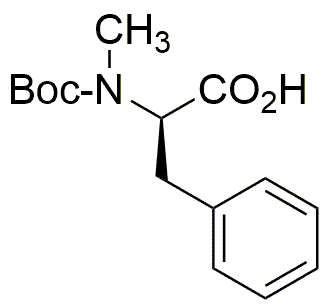Na-Boc-Na-Methyl-D-phenylalanine is widely utilized in research focused on:
- Peptide Synthesis: This compound serves as a protecting group in the synthesis of peptides, allowing for selective reactions without interfering with other functional groups. This is particularly beneficial in pharmaceutical development where precise modifications are crucial.
- Drug Development: It plays a role in the design of new drug candidates, especially in the field of neuropharmacology, where modifications to amino acids can enhance the efficacy and selectivity of therapeutic agents.
- Biochemical Research: Researchers use it to study protein interactions and enzyme mechanisms, providing insights into biological processes that can lead to innovative treatments for diseases.
- Cosmetic Formulations: The compound is explored in the cosmetic industry for its potential to enhance skin penetration of active ingredients, improving the effectiveness of anti-aging and moisturizing products.
- Food Industry: It may be utilized in flavor enhancement and food additives, contributing to the development of novel food products with improved taste profiles.
General Information
Properties
Safety and Regulations
Applications
Na-Boc-Na-Methyl-D-phenylalanine is widely utilized in research focused on:
- Peptide Synthesis: This compound serves as a protecting group in the synthesis of peptides, allowing for selective reactions without interfering with other functional groups. This is particularly beneficial in pharmaceutical development where precise modifications are crucial.
- Drug Development: It plays a role in the design of new drug candidates, especially in the field of neuropharmacology, where modifications to amino acids can enhance the efficacy and selectivity of therapeutic agents.
- Biochemical Research: Researchers use it to study protein interactions and enzyme mechanisms, providing insights into biological processes that can lead to innovative treatments for diseases.
- Cosmetic Formulations: The compound is explored in the cosmetic industry for its potential to enhance skin penetration of active ingredients, improving the effectiveness of anti-aging and moisturizing products.
- Food Industry: It may be utilized in flavor enhancement and food additives, contributing to the development of novel food products with improved taste profiles.
Documents
Safety Data Sheets (SDS)
The SDS provides comprehensive safety information on handling, storage, and disposal of the product.
Product Specification (PS)
The PS provides a comprehensive breakdown of the product’s properties, including chemical composition, physical state, purity, and storage requirements. It also details acceptable quality ranges and the product's intended applications.
Certificates of Analysis (COA)
Search for Certificates of Analysis (COA) by entering the products Lot Number. Lot and Batch Numbers can be found on a product’s label following the words ‘Lot’ or ‘Batch’.
Número de catálogo
Número de lote/lote
Certificates Of Origin (COO)
This COO confirms the country where the product was manufactured, and also details the materials and components used in it and whether it is derived from natural, synthetic, or other specific sources. This certificate may be required for customs, trade, and regulatory compliance.
Número de catálogo
Número de lote/lote
Safety Data Sheets (SDS)
The SDS provides comprehensive safety information on handling, storage, and disposal of the product.
DownloadProduct Specification (PS)
The PS provides a comprehensive breakdown of the product’s properties, including chemical composition, physical state, purity, and storage requirements. It also details acceptable quality ranges and the product's intended applications.
DownloadCertificates of Analysis (COA)
Search for Certificates of Analysis (COA) by entering the products Lot Number. Lot and Batch Numbers can be found on a product’s label following the words ‘Lot’ or ‘Batch’.
Número de catálogo
Número de lote/lote
Certificates Of Origin (COO)
This COO confirms the country where the product was manufactured, and also details the materials and components used in it and whether it is derived from natural, synthetic, or other specific sources. This certificate may be required for customs, trade, and regulatory compliance.


